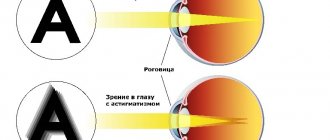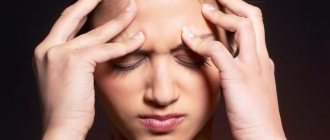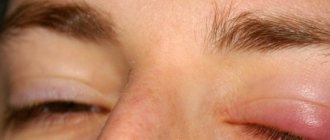Home Diseases Eye diseases A–Z
From All About Vision
Eye pain is a commonly used term to describe discomfort on the surface, inside, behind, and around the eyes.
The pain can be unilateral or bilateral. In other words, you may experience pain in only the right eye, only in the left eye, or discomfort in both eyes. There is no evidence that pain in the right eye occurs more often than in the left, and vice versa.
In some cases, such as an eye injury, the cause of the pain is obvious. But it is often difficult to understand why exactly the eye hurts.
To complicate matters, the intensity of the pain does not indicate the severity of the underlying cause of the discomfort. In other words, a relatively minor problem, such as a superficial injury to the cornea, can cause unbearable pain.
And some very serious eye diseases - cataracts, macular degeneration, glaucoma, retinal detachment and diabetic retinopathy - are completely painless.
ARE YOU READY TO TEST YOUR VISION? Find an eye doctor near you .
Pain in the eyes can be accompanied by various sensations and symptoms, which will help the ophthalmologist determine the cause of the discomfort and prescribe the correct effective treatment for pain in the eyes. For example:
- Sharp, stabbing sensation
- Burning in the eyes
- Dull aching pain
- Feeling like something is “in” the eye (foreign body sensation)
Eye pain is often accompanied by blurred vision, redness (bloodshot eyes), and sensitivity to light.
Causes not related to the eye
Overwork
It happens to people who spend a lot of time at the computer. May occur in those who do work that requires a lot of concentration, with documents and numbers. In this case, there is a load on the eyes, as a result of which pain is felt when moving the eyeball.
| If this happens systematically, it is necessary to reconsider your diet and lifestyle. You also need to start doing eye exercises. |
Headache
The symptom occurs during migraine. It is characterized by frequent manifestations of throbbing pain radiating to the eyes and temples. Sometimes it occurs due to stuffiness. They are accompanied by increased sensitivity to bright light and music. Therefore, irritability and decreased attentiveness and performance are observed.
Infectious process
The mucous membrane connects the sinuses and eyes. When infections enter the body, they can also irritate nerve endings, resulting in pain when blinking and moving. It is often painful to suddenly switch attention or look at dynamic objects. Accompanied by tearfulness and sneezing. It goes away either during treatment of the infection or with complete recovery.
| If the pain when moving the eyeball remains, it is necessary to undergo a re-examination to check for other causes of the disease. |
Incorrectly fitted contact lenses or glasses
In this case, fatigue, discomfort or even pain quickly sets in. To purchase optics, you need recommendations that only a professional can give. Also, glasses can be designed for different activities. Some are for work, others are for regular wear. And if you constantly use glasses designed for work, this will not lead to anything good. Sometimes the reason is simply an uncomfortable frame or incorrect selection of diopters.
Extended wear of contact lenses
Pain and discomfort cause neglect in use. If you wear them for a long time, forget to take them off at night or store them incorrectly. Viruses or dry eyes sooner or later cause pain. An accidentally introduced foreign body is not always easy to remove. Buying low-quality lenses in unprofessional stores leads to damage to your health. Return to contents
High blood pressure
A popular cause of pain. With high blood pressure, your head may begin to hurt severely during sleep, and when you wake up, you may feel a state of heaviness and blurred vision. If the pain does not go away, this means that there is pressure inside the organ itself and treatment is necessary. This may be related to the development of glaucoma. Typically, treatment begins with drops. It is necessary to pay attention to other disturbing symptoms to accurately determine the diagnosis.
Prevention
It is impossible to completely eliminate pain when moving the eyeballs, but it is quite possible to minimize the risks of developing pathologies dangerous to health. Monitor the condition of the blood vessels, and if you notice any alarming symptoms, take immediate action - namely, consult a doctor and follow his recommendations. You need to be especially careful about intraocular pressure, a sharp increase in which can cause vascular ruptures.
If you constantly work at the computer and get very tired, do preventive exercises regularly. The eyes will focus at different points, and the muscles will not have time to overexert themselves. Eliminate all potentially dangerous factors such as lack of sleep, harmful working conditions.
If the eyes are damaged by viruses or bacteria, it is necessary to undergo treatment with special medications that will reduce the negative impact on the eyes to a minimum. Avoid getting foreign objects into the organs of vision; if a problem has already occurred, do not let things take their course and do not try to get a speck, piece of glass, plastic, etc. yourself.
If your eyeballs constantly hurt after sitting for a long time at the computer or in front of the TV, this symptom, although alarming, is considered normal. In the case when the pain is not associated with prolonged stress, we can talk about the presence of serious systemic, local diseases. Need help from a specialist.
Eye pathologies as a cause of pain
Inflammation of the membranes of the eyes
Occurs due to infections, viruses, allergies. Painful sensations are always present, since contact with such a shell is always felt and causes discomfort.
| If the inflammation occurs due to an infection or virus, the patient should be isolated until recovery, as he can infect other people. |
Treatment is accompanied by regular check-ups with an ophthalmologist. Along with pain, the patient experiences intolerance to bright light. For treatment, it is necessary to use medications, as well as regularly rinse the eyes with clean warm (but not hot!) water. Antibacterial medications are usually used.
Uveitis
The symptoms and nature of the disease are very similar to the previous one. In general, this is an inflammation of the choroid. Photophobia, tearfulness, and pain appear. There is little blood flow in that area, so some substances are retained there. Uveitis can also develop due to allergies. Blurred images are observed.
| If you do not resort to treatment, the disease will gradually worsen. In the end, you can get completely blind. |
Iritis
Occurs as a result of injuries, infections, allergies, metabolic disorders or as a result of past surgical operations. The symptom is a sharp decrease in the quality of the visible image. At any degree of distance, objects blur. In addition, general weakness, poor physical condition, burning and headache pulsating in the eyebrow area are often observed. Diagnosis is carried out using a laboratory method. It is treated with antiviral, anti-inflammatory and other medications.
Dry eye syndrome
With this diagnosis, the human eye practically loses its ability to produce a sufficient amount of tears. This syndrome occurs for various reasons. Some of them are associated with external influences, others with the physical effects of the body. For example, wearing lenses for a long time without removing them. Dry eye is common in older people, especially women during menopause. Severe symptoms:
- Severe discomfort when wearing contact lenses
- Burning sensation in the visual area
- Stitching pain
- Redness, irritation
To get rid of dryness, you need to undergo a medical diagnosis, and also stop smoking, minimize visits to baths and saunas, avoid strong winds, or wear glasses.
Return to contents
Glaucoma
Unfortunately, this disease is very common and without the use of control methods it leads to complete blindness of a person. It is associated with disruption of visual signals to the brain, cell death and other disorders. Glaucoma is not understood as a single disease, but as a whole sector with approximately the same causes.
The difference is in the areas affected and the complexity of the course. Symptoms include pain and burning in the visual area, redness, tearing and decreased visual acuity in the evening and at night.
Optic neuritis
This causes possible symptoms, among which pain when moving the eyes will definitely be present. Occurs in chronic or acute diseases resulting from infections. For example, sore throat or flu. Neuritis occurs due to diseases of the nasal cavity or even dental ailments. The main symptom is decreased visual acuity, blurred images and lack of clarity. A pounding headache often occurs, and flare-ups occur periodically.
Shingles
This disease is viral in nature. It is definitely reflected on the skin in the form of pus bubbles and redness. In this case, these marks appear in the eyelid area. The causative agent is herpes or ophthalmoherpes.
| The increasing frequency of episodes when this disease occurs in representatives of different age categories is due to the poor environmental situation in almost all cities. |
Diseases leading to vasoconstriction
The most popular disease in this category is atherosclerosis. In general, ailments associated with narrowing of blood vessels in the brain occur due to poor circulation in the head area. For treatment, consultation with an ophthalmologist is necessary. It is carried out using both medication and laboratory methods, depending on the severity of the disease. The severity of symptoms depends on this.
In case of injury or foreign body penetration
Contact with such a body is dangerous by disrupting the functioning of nerves and organs. Some of them can cause infection. For example, conjunctivitis. In this case, you should get rid of the litter or pee, get checked by a doctor and start taking antibacterial and antiviral drugs.
“The eye hurts!” - a signal not only for ophthalmologists
Sometimes we turn to ophthalmologists, seemingly at the right place, complaining of hemorrhages in the area of the eyeball, pain or fog in the eyes.
But it turns out that this is just the tip of the iceberg of a completely different problem, which is dealt with by completely different doctors. For example, the flickering of floaters may be associated with age-related changes in the vitreous body (the part of the eye that helps it maintain its shape, occupying up to 2/3 of the volume). Or it can be a direct consequence of excessive physical activity, stress, diabetes. You understand that treatment will vary greatly. In what other situations should you keep your ears open, not excluding consultations with related specialists? - said Alexander LAVER, an ophthalmologist at the 20th Minsk polyclinic.
Hypertension also “knocks” in the eyes.
Normally, in the fundus of the eye, the arteries and veins have a straight course, their ratio is 2 to 3, and there are no changes in the retina. But with a constant increase in blood pressure over time, a different picture emerges. For example, sclerosis of the walls of the arteries develops - then their color changes, to the point that the doctor talks about the symptoms of “copper” or even “silver wire”. The veins begin to twist and expand, their ratio with the arteries becomes 4 to 1. The Salus-Hun symptom may occur (when the artery presses on the vein until its patency is impaired), and the optic nerve may be damaged. Floaters, blurred vision, a temporary decrease in its acuity - these are generally “classics of the genre” during a hypertensive crisis. Of course, an examination of the fundus will not be superfluous. But the main thing is to still fight the root cause, that is, to take the pressure back under control.
Hypertension can lead to another condition - hemorrhage in the conjunctiva. So does excessive sneezing or physical stress, such as heavy work or childbirth. It's all about the weakness of the walls of blood vessels. From the outside it looks scary: sometimes the eye seems to be completely swollen with blood, or even the eyelids become purple, even bluish. There is no need to be too afraid here: most often everything resolves on its own, even if sometimes it takes longer than a month. Yes, there may be hemorrhage on the retina, but then vision decreases. If this is not the case, you don’t have to run headlong to an ophthalmologist. And drip some emoxypine and potassium iodide. To strengthen the walls of blood vessels - angioprotectors containing rutin. Just read the instructions carefully first - there are contraindications.
PHOTO BY ALEXANDER KUSHNER
Migraine masks
What about eye pain? Although ophthalmologists are often approached with such complaints, as a rule, this is the domain of neurologists. Firstly, this is how trigeminal neuralgia makes itself felt, which occurs when it is damaged or compressed. Then attacks of sharp, burning, stabbing, twitching pain occur, sometimes affecting the eyes. Secondly, we can talk about a banal migraine. However, if this is the most common form of the disease, without an aura, then the eye rarely suffers: there is simply a headache, pallor, and nausea appear. But with the aura the situation is different: the harbingers of an attack are spots and zigzags flashing before the eyes, then some area of vision on one side disappears for a while. And only then comes the actual headache. Treatment, as with trigeminal neuralgia, comes down to pain relief and observation by a neurologist. For prevention, you should avoid stress, lack of sleep, alcohol, and do not overindulge in coffee.
Oddly enough, people also turn to an ophthalmologist with signs of vertebral artery syndrome. It passes in the cervical region, in a kind of canal of the vertebrae and their processes, and with osteochondrosis it is compressed. Or congenital deformation or narrowing of blood vessels due to blood clots, atherosclerosis, and a number of other reasons do their job. And since the vertebral arteries supply the brain and inner ear, they also suffer from lack of blood circulation. Hence the so-called cervical migraine (pain starting in the neck and rising through the back of the head to the temples), tinnitus, partial numbness of the face or limbs, dizziness, fainting. As an option, there is pain behind the eyes, loss of visual fields, again zigzags, dots, fog, up to temporary blindness. This syndrome is dangerous because, against the background of chronic disruptions in the blood supply to the brain, there is a risk of stroke. Although diagnosing the root cause is not difficult. Usually an ultrasound of the brachiocephalic arteries, an X-ray of the cervical spine, and an MRI of the brain are performed. And the treatment regimen includes anti-inflammatory and blood flow-improving drugs, neuroprotectors and antihypoxants. Plus prevention: massage, exercise therapy, physiotherapy, swimming pool. Of course, all this is prescribed and under the supervision of a neurologist.
It turns out that the complaint “hurts the eye!” very, very vague. On the one hand, the symptom should not be dramatized, and on the other hand, it should not be downplayed. This is not a threat to vision as such, but a clear signal: somewhere in the body there is a truly problematic point.
Dr. Laver advises
Do not neglect consultation with a neurologist or therapist and be sure to control your blood pressure.
BY THE WAY
Floaters, black dots, “spiders” that fly before the eyes of more than 80% of people are evidence of destruction of the vitreous body. Its substance is destroyed due to myopia, injury, excessive physical activity, but most often it is the influence of age. Usually there are no complications. Yes, some people experience visual discomfort from flickering, but they get used to it over time. The problem is that it may be a detachment of the posterior hyaloid membrane or retina. Then the flashing of lightning joins the flies. If this is your case, the path lies with an ophthalmologist. There is no cure for this eye condition as such. Emoxipine, potassium iodide, and vitamins can be used from drops. Inside there are various dietary supplements, which, oddly enough, sometimes help. You can also undergo a course of vascular treatment. Well, if possible, try not to physically overwork. This advice primarily concerns retired summer residents.
Diagnostic methods for eye pain
Peripheral vision
Many people are familiar with it. Only one eye is tested at a time and the other is closed. Next, the doctor will move the point and observe the behavior of the organ of vision.
External examination
The ophthalmologist will examine the condition of the cornea, eyelids, eyelashes, and orbits. The echobiometry method, carried out with a special device, is very often used.
Return to contents
Coordination check
Aimed at studying the condition of muscles. This method is characterized by constant closing and opening of the eyes with a special blade and observation of the behavior of the muscles and the ability to concentrate vision on an object. Can be carried out using a special lamp.
Dilated pupil examination
This examination method is often used when glaucoma is suspected. With the help of special drops, the pupils dilate. This is necessary for the doctor to receive the most reliable information.
In severe situations, fundus examination is used. Special lamps and devices that come into contact with the lens of the eye can be used here. But the patient does not feel anything, thanks to special drops that act like anesthesia.
Treatment
Drops to relieve pain and fatigue
Recommend:
- Taufon. Used to relieve inflammation.
- Strix. A special preparation for the correction and restoration of vision.
- Inoxa. A safe remedy for fatigue.
- Blink intensive. Protect and protect your eyes when reading and working at the computer.
Drops to relieve pain and redness
- Vial. Provides anti-edematous and anti-inflammatory effect.
- Visin "Pure Tear". Used to relieve redness and dry eyes.
- Korneregel. Removes signs of inflammation and irritation.
- Irifrin. Good drops for dryness and high intraocular pressure.
Folk remedies
The most popular is, perhaps, a cotton swab soaked in tea leaves (cooled). They need to rub their eyes regularly. The second remedy is calendula infusion (a spoonful of leaves in a glass of boiling water). They need to wipe their eyelids morning and evening. The third folk remedy is chamomile decoction. Steam the inflorescences in a glass of hot water and leave until completely cool.











